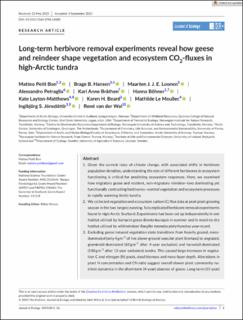| dc.description.abstract | 1. Given the current rates of climate change, with associated shifts in herbivore population densities, understanding the role of different herbivores in ecosystem functioning is critical for predicting ecosystem responses. Here, we examined how migratory geese and resident, non-migratory reindeer—two dominating yet functionally contrasting herbivores—control vegetation and ecosystem processes in rapidly warming Arctic tundra.
2. We collected vegetation and ecosystem carbon (C) flux data at peak plant growing season in the two longest running, fully replicated herbivore removal experiments found in high-Arctic Svalbard. Experiments had been set up independently in wet habitat utilised by barnacle geese Branta leucopsis in summer and in moist-to-dry habitat utilised by wild reindeer Rangifer tarandus platyrhynchus year-round.
3. Excluding geese induced vegetation state transitions from heavily grazed, moss-dominated (only 4 g m−2 of live above-ground vascular plant biomass) to ungrazed, graminoid-dominated (60 g m−2 after 4-year exclusion) and horsetail-dominated (150 g m−2 after 15-year exclusion) tundra. This caused large increases in vegetation C and nitrogen (N) pools, dead biomass and moss-layer depth. Alterations in plant N concentration and CN ratio suggest overall slower plant community nutrient dynamics in the short-term (4-year) absence of geese. Long-term (15-year) goose removal quadrupled net ecosystem C sequestration (NEE) by increasing ecosystem photosynthesis more than ecosystem respiration (ER).
4. Excluding reindeer for 21 years also produced detectable increases in live above-ground vascular plant biomass (from 50 to 80 g m−2; without promoting vegetation state shifts), as well as in vegetation C and N pools, dead biomass, moss-layer depth and ER. Yet, reindeer removal did not alter the chemistry of plants and soil or NEE.
5. Synthesis. Although both herbivores were key drivers of ecosystem structure and function, the control exerted by geese in their main habitat (wet tundra) was much more pronounced than that exerted by reindeer in their main habitat (moist-to-dry tundra). Importantly, these herbivore effects are scale dependent, because geese are more spatially concentrated and thereby affect a smaller portion of the tundra landscape compared to reindeer. Our results highlight the substantial heterogeneity in how herbivores shape tundra vegetation and ecosystem processes, with implications for ongoing environmental change. | en_US |

